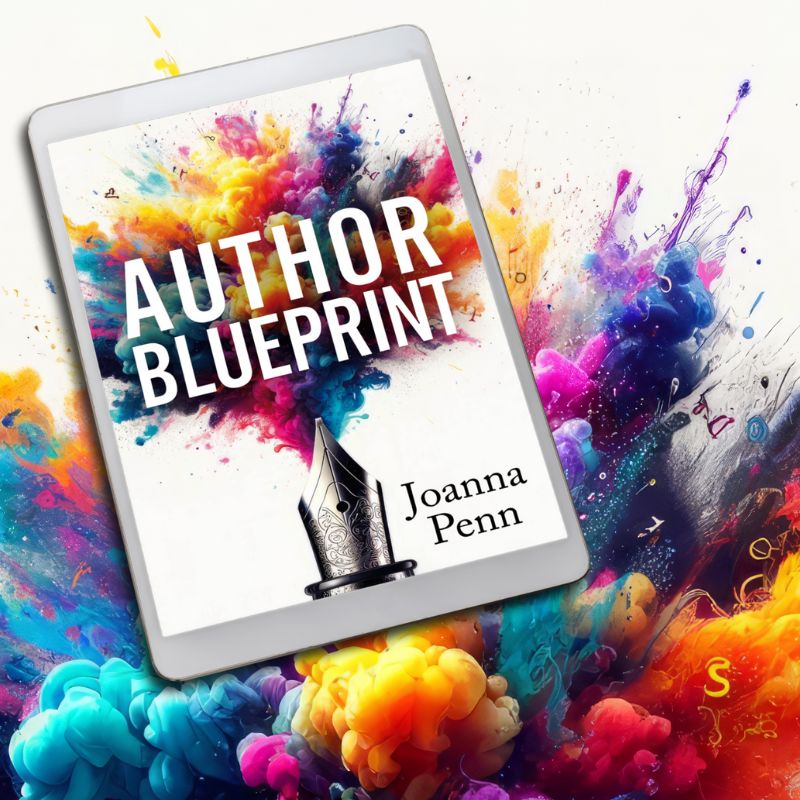OLD POST ALERT! This is an older post and although you might find some useful tips, any technical or publishing information is likely to be out of date. Please click on Start Here on the menu bar above to find links to my most useful articles, videos and podcast. Thanks and happy writing! – Joanna Penn
A writer's life is not an inherently healthy one.

We sit for long periods of time, and studies show that sedentary behavior is bad for us. We hunch over keys, creating back problems. We stare at screens, giving us headaches and we type and mouse a lot. All of this can lead to Repetitive Strain Injury.
I had back problems in the last few years that were solved by using a Swiss ball instead of a chair, and moving a lot more. We don't have a car so naturally walk a lot anyway.
But in the last few months, after a heavy writing stint in a cafe with tables at the wrong height, I developed RSI in my right wrist, elbow and upper arm.
After some initial denial, I visited the doctor, went to a physio and had an ergonomic assessment at my home desk. Since then, I've been using an Evoluent sideways mouse, as well as using my left hand a lot more. I'm practically ambi-mouse-strous these days 🙂 I've also been doing exercises to strengthen the arm.
I tried Dragon Dictate but just found it frustrating to use. I considered moving to paid transcription as Kevin J Anderson does with his walking/talking approach, but with everything else I was doing, the pain lessened. It's a lot better now but we all need to be aware of the possible strain injuries we can develop.
Lots of people have emailed me with tips on various ways of dealing with RSI, because, unsurprisingly, so many of us suffer

with it. Marianne Sciucco emailed me with her own story that, while extreme, is important because it emphasizes how bad things can get.
Prevention will always be better than pain and (hopefully) cure later on, so this is your wake-up call, writers! Sort out your physical writing position and exercise and stretching routine BEFORE anything happens.
Here's Marianne's story and also her tips at the end. Please do leave a comment with your thoughts and experiences of having or treating RSI as this is something critically important to the health of the writing community.
“What about your writing?”
This was a question I had not considered after my visit with the thoracic surgeon in March 2007. He’d advised me I needed two surgeries – the removal of both first ribs – to relieve symptoms caused by thoracic outlet syndrome (TOS). This would necessitate a leave of absence from my job as a hospital nurse case manager for a minimum of six months.
Devastating news.
I'd suffered from TOS and a collection of other repetitive strain injuries for the last year, undergoing months of physical therapy which had not corrected the problem.
My biggest concern at the time was missing work. My department was undergoing great change as we moved into a fully computerized system to perform our duties. I was 100 percent in favor of these changes and looked forward to being a leader in the transition. A six-month leave of absence would effectively remove me from the process. Little did I know that once I took that leave of absence I would never return to that job.
But it was the question asked by a coworker who had a great interest in my writing that rattled me.
“What about your writing?”
This question stopped me in my tracks. What about my writing? These injuries had impacted my writing routine for months. I rarely spent time on my projects because typing and using a computer caused tremendous pain. Prior to my injuries, I had completed my first novel and was looking for an agent. I’d started a second book. One of my short stories had won a contest. I had another I was shopping around.
I am, by nature, stubborn, and refused to give in to the pain, revising my stories and querying agents whenever I could. I was also in denial. How absurd that something like this would keep me from pursuing my goals!
But these repetitive strain injuries threatened to take more from me than my 15-year career at this hospital. They would take away my ability to write for years, and leave me unable to use a computer for days on end.
My purpose in relating this story is not to gain sympathy but to let others know that repetitive strain injuries caused by computer use are real, scary, and difficult to treat.
Many things can cause repetitive strain injuries but in my case the problem was hours of keyboarding and data entry at a workstation that did not properly or ergonomically support my body mechanics. I traveled throughout the hospital pushing a utility cart with a laptop and a printer as I visited each unit to do chart review 35 hours each week. At first I laughed about waking up at night with numb hands, thinking I had somehow slept wrong.
Then the pain began in my right bicep, a tearing, almost ripping pain when I reached for or pulled something. I wondered if I had broken my arm – perhaps a hairline fracture? My doctor sent me for x-rays which were unremarkable, no fractures. By this time I was already using night splints to help reverse the mild carpal tunnel syndrome I had in both wrists.
The arm pain grew worse and began to affect my shoulder. The doctor ordered physical therapy, and while doing the exercises I realized that when I raised my arms up over my head they'd become completely numb and very heavy. I could not do this simple movement for more than 15 seconds.
Then came changes in my hands, fingers that turned blue, sometimes a blackish blue, or red and puffy, or white and ice cold. The numbness and tingling in my hands continued. The diagnosis: thoracic outlet syndrome, something I had never heard of although I analyzed medical records for a living. I also developed tendinitis in my right thumb and both elbows. My right shoulder became frozen. It was a collection of musculo-skeletal injuries which had to be addressed one at a time.
At this point, I was unable to continue working without more aggressive intervention and opted for surgery. Over the next four years, the two ribs were removed and the right shoulder explored. PT, OT, massage therapy, and chiropractic continued, along with all kinds of lotions, potions, and pills. Many of my symptoms gradually improved, however, the chronic pain continues to affect my right arm, both hands, and my neck and I suffer frequent severe headaches. I am permanently partially disabled.
Throughout all this, I had given up on my plans to become an author, putting my work aside.
Life passed me by as I watched every episode of Law and Order ever produced. I read hundreds of books, novels, in particular, but many dedicated to writing and publishing as I continued to hope that one day I would resume my writing career.
This would not happen until 2012. A friend had published a book on Kindle and suggested I do the same. I figured I had  nothing to lose and went about preparing my Alzheimer’s novel Blue Hydrangeas for publication.
nothing to lose and went about preparing my Alzheimer’s novel Blue Hydrangeas for publication.
This took a year. Yes, one year, as I struggled with the pain caused by keyboarding to complete my project followed by days and weeks of computer avoidance to recover.
If you experience numbness or tingling in your hands or fingers, or any kind of pain in your arms, shoulders, neck, or upper back after a writing session that is not relieved by simple stretching, please take it seriously.
Once these injuries set in, your muscle memory will adapt and this will become your new normal, close to impossible to reverse. In spite of three surgeries, countless therapy sessions, and umpteen medications this pain continues to control my life.
In April 2010, I was fortunate to return to work at a new job, part-time, but still chained to a computer most of the day. My two work days require a minimum one day’s rest from the computer. This leaves me with four days during the week with a maximum writing time of about two hours per day to write as much as I possibly can. This includes finishing the novel I’ve been working on for four years and tending to my website, social media, email, and all the other business that makes up an author’s life.
This is a writer’s life with RSI.
The frustrating part is that the mind continues to imagine and explore, to come up with new ideas, and the desire to write remains strong. It is a constant battle of mind over matter, a roller coaster of emotions intertwined with varying levels of pain and discomfort. There is constant acquiescence to disability. Imagine how difficult it is to complete a project under these conditions.
If you encounter RSI or TOS symptoms see your doctor immediately.
Here are some ways to help alleviate the discomfort and treat the pain:
- This means the avoidance of all keyboarding, even on a tablet or smartphone. [Note from Joanna: I have definitely found that I need to only use my left arm for texting/twitter etc in order to rest the right from the cellphone.]
- Ice the affected area to relieve pain and inflammation.
- Heat to the affected area is also helpful. You can alternate heat and ice.
- Advil and other OTC remedies can relieve pain and inflammation. This includes topical remedies such as Topricin, Thermacare Wraps, etc.
- Hand splints may ease the discomfort of carpal tunnel syndrome.
- Have realistic expectations. If you’re having a bad bout, alter your plans and goals to allow adequate time for rest and repair of injured tissues, muscles, tendons, etc. [Note from Joanna: I've found this has gone on for a lot longer than expected, and even though it's a lot better, I'll forget and pick something up the wrong way and the pain will kick off again. So be careful.]
- Mix it up. Switch from a PC, to a laptop, to a smartphone, to a tablet, offsetting the pressure on your damaged hands, neck, arms, etc. Go back to pencils and paper. Type up your work when you’ve recovered or ask someone else do it for you.
- Practice proper ergonomics: ears over shoulders, shoulders over hips. Be careful not to “turtle head,” thrusting your head forward to see the screen. This can become a permanent posture and strains your neck muscles. [Note from Joanna: I am totally guilty of turtle head. Have someone take a picture of you while you're working in your normal posture. It may be shocking.]
- Use a timer to remind you when it’s time to take a break.
- Dictation is a wonderful tool to write hands-free.
- Consider a new keyboard. I use a Logitech gaming keyboard which substitutes a glide pad for the mouse, eliminating mouse work, a primary cause of RSIs.
- Delegate, if possible. An author’s assistant can handle tasks that exacerbate your injuries. I offer an internship in self-publishing to students at my community college. It’s a win-win for both of us. A Virtual Assistant can also make life easier.
- If you experience pain STOP! Take a break. Stretch those muscles! Do something else: a load of laundry, the dishes, shopping, or a long walk.
- Physical and occupational therapy, chiropractic, and massage can correct problems, relieve pain, and eliminate the need for surgery, which is always a last resort.
For more information, here is an excellent explanation of computer-related RSI’s by Paul Marxhausen from the University of Nebraska – Lincoln.
What's your experience with RSI? Do you suffer from pain associated with writing? What have you done about it? Please do leave a comment below with your thoughts and experiences of having or treating RSI as this is something critically important to the health of the writing community.
About the Author

Marianne Sciucco is not a nurse who writes but a writer who happens to be a nurse. A lover of words and books, she dreamed of becoming an author when she grew up, but became a nurse to avoid poverty. She later brought her two passions together and writes about the intricate lives of people struggling with health and family issues.
Her debut novel, Blue Hydrangeas, an Alzheimer’s love story, is a Kindle bestseller, IndieReader Approved, a BookWorks featured book, winner of IndieReCon’s Best Indie Novel Award, 2014, and a Library Journal Self-e Selection. A native Bostonian, she lives in New York’s Hudson Valley, and when not writing works as a campus nurse at a community college.
You can find Marianne at her website or @mariannesciucco on twitter. Her books are available on all online stores and you can find Blue Hydrangeas here on Amazon.


For those of you working on Windows or Linux, I recommend Workrave, a freeware “a program that assists in the recovery and prevention of Repetitive Strain Injury (RSI). The program frequently alerts you to take micro-pauses, rest breaks and restricts you to your daily limit”.
http://www.workrave.org
You can configure the frequency of the alerts and the program shows a variety of quick exercises (for the hands/arms, neck, back and eyes). It’s more than just a timer. And, best of all, it’s free!
Regards,
Cris
Wow Chris, this sounds fantastic. I’m always looking for something to make my work easier. Prevention is the best antidote. Thanks for writing.
What a great discussion! I want to thank Joanna for hosting me on the blog and allowing me to tell my story. I’m sorry to hear so many others are suffering, Joanna and I suspected this was a widespread problem for authors and it looks like our suspicions were correct. While all of the advice offered may be helpful, it’s important that we listen to our bodies and seek medical help asap when we feel something’s not right. Also, this isn’t something we can handle alone. There’s a lot of trial and error. Seek support. There are some great groups on Facebook for both TOS and RSI, as well as chronic pain. Remember you are not alone, and the medical establishment is starting to come around on these issues.
I had a narrow escape with RSI. Years ago, while working on a magazine, I developed those symptoms described above – pain, tingling. Doctors couldn’t find anything to snip or remove, unlike Marianne, so they resorted to guesswork with acupuncture, then electroacupuncture (not recommended). Acupuncture hurts, BTW. Eventually, I sorted myself out with weight training and ergonomic gear. Other journalists I knew weren’t so lucky, and never touched keyboards again (I put my experiences into a novel, in which the main character loses her career as a musician because of insolvable pain).
Funnily enough, I wrote about my experience recently, and what I did about it – if it’s okay, Joanna, I’ll put the link here, but delete it if that’s inappropriate! https://nailyournovel.wordpress.com/2015/06/14/how-i-cope-with-writers-rsi-and-when-your-books-come-back-to-haunt-you/
I had crazy problems with my hands and wrists (lots of other health issues too) before getting tested for food allergies and finding out that I reacted to gluten, dairy, and some lesser culprits. None of the ergonomic changes helped me (I tried everything, including mousing with my feet–seriously–and Dragon Naturally Speaking). Changing my diet and eliminating the problem foods did, almost immediately. Over ten years later, the problems haven’t returned. I can type 10,000 words a day on my laptop and from my couch, and it doesn’t bother me (not that I recommend this, mind you). Cheating on the diet causes the inflammation and some soreness to come back though.
I’m sure it won’t be the solution for everyone, but it’s sure an inexpensive and easy thing to check these days (about a $100 blood test can get you tested for the 100 more common food intolerances).
Thanks for that Lindsay – our bodies are far more integrated than we think 🙂 everything affects everything – so this is a good tip. My husband cut out onions and garlic after years of IBS (the FODMAP diet) and it was like a miracle!
Ever since I got a laptop with a TOUCH SCREEN, my wrist pain has gone down significantly.
I do more with my left hand and a lot less clicking in general thanks to the touch screen.
Best health wishes to those who are dealing with it at the moment!
Hi Joanna,
Thank you for giving me the opportunity to share some of my story with chronic pain.
I don’t have RSI but I do have chronic pain. My pain issues stemmed from a work injury when I was a firefighter paramedic. I subsequently had hip surgery and have had persistent pain since (my initial injury was in January of 2010, my surgery March of 2011).
I had to medically retire from my job as a firefighter because of it but started a new path in life, one that took me back to graduate school in kinesiology, with an emphasis in sport and exercise psychology and a research focus in pain science.
When I went back to school I chose kinesiology because I thought that all pain was tissue related, that it was a result of injury or poor postures or poor movement. But I learned that persistent pain is not all in the tissues, that there’s really no such thing as poor posture or poor movement.
Pain is a biopsychosocial phenomenon that is consciously experienced as a result of many different inputs into our nervous system and brain, of which tissue status is only one. For more on the difference between injury and pain, this is a good intro: http://www.mycuppajo.com/chronic-pain-doesnt-equal-injury/
Just as relevant are our thoughts, our beliefs, our expectations, our previous history, our surroundings, our knowledge of other people we know that may have experienced similar pain, our stress levels, our diet, our immune function. By no means does this mean that pain is ‘all in our head’, though, for more on that, this post might help: http://www.mycuppajo.com/its-all-in-your-head/
This doesn’t mean postures and movement aren’t important, they are, but the important thing is to move through postures throughout the day. The problem doesn’t lie in any specific posture, it’s in sustaining any posture for a length of time. So it’s important to keep moving and provide the nervous system, muscles, and joints with different stimuli throughout the day. For more on this, this post may help: http://www.mycuppajo.com/shift-in-movement-part-1/
Your suggestions on this were spot on! But I want to stress being careful with language. As a writer, you know how powerful language is, and the language we use to tell our own stories, to ourselves and to others, is a powerful factor in our experience of pain.
I wrote a post on this here: http://www.mycuppajo.com/how-the-words-we-use-can-limit-our-ability-to-heal/
My blog is primarily on my experiences with chronic pain and how I’m successfully changing my experience of pain, informed by my education in pain science, and it’s intended to inform and empower people with pain to change their own experience and live full, valued, meaningful lives, even if the pain sticks around. Even better, and just as possible, is overcoming pain all together.
Hope some of this is of some use to you! I have found that pain science education was life changing for me. Understanding that pain does not equal damage and that hurt doesn’t always equal harm allowed me to stop worrying so much about the pain and to stop fearing it so much. (for more on pain and fear, this post may provide some insights: http://www.mycuppajo.com/fear-of-movement-and-persistent-pain/
Keep doing what you’re doing, it sounds like you’re on the right track for your own pain issues! And if you have any questions at all, don’t hesitate to ask. This is my passion!
Cheers,
Joletta
Thanks for sharing your personal story Joletta – this is such an important topic for writers.
Thank you for providing the opportunity and for sharing the message 🙂
Hi Joanna,
I’m sorry to hear what you and Marianne have gone through with RSI. I’ve just written my first non-fiction book and work as a copywriter at an ad agency and find from time to time that my right shoulder and my forearm hurt. I knew it had to do with typing but I thought it was just me and tried to take breaks even though taking a break from writing is difficult when writing is my job and hobby 🙂 I’m glad to hear I’m not alone though sad and alarmed to read about Marianne’s experience and learn how bad RSI can get. I’ll take the pain in my hand more seriously now and will pay more attention to my posture.
Thanks for this enlightening post.
Lape.
Thanks for sharing this! I appreciate the tips, and I’m going to buy an ergo mouse. One thing I noticed was that when I was boxing and doing a lot of martial arts, I had no issues. I stopped for a while after I moved to a new city, and suddenly I began experiencing carpel tunnel symptoms for the first time in my life. I’ve since returned to boxing because it seems to help, and I recommend giving it a try to anyone who has issues. Just make sure you get coaching from a professional to make sure you are using good form.
Joanna, I know you’ve mentioned in the podcast that yoga has nearly eliminated your RSI. Are there any particular poses that you’ve found especially helpful? I’m trying to get into a good stretching routine to help keep my RSI at bay. Thanks!
Yoga is more of a wholistic approach to the body – and my RSI was more connected to my back than to my arm 🙂 I do find that all the twists are particularly good though.